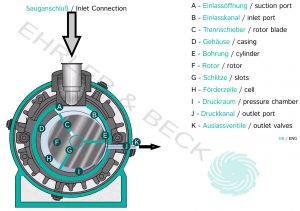Rotary vane pressure-vacuum pumps, oil-free
The simple construction with only one shaft and a direct drive results in robust, long-life pressure-vacuum pumps with low maintenance and operating costs. The pressure-vacuum pumps work completely oil-free, the individual working chambers are separated by slides with a long service life. Suction filter and control valve are integrated in the pressure-vacuum pumps, additional accessories can be added without any problems. The blown air cooler, which is also integrated, guarantees a very low blown air temperature. The compact cover enables low noise emissions and low heat emissions. With optional corrosion protection, the vacuum pumps can also be used for the extraction of moist air.
An eccentric within the cylindrical housing bore (D) bearing rotor (f) almost touches the above hole (E). In several rotor slots (G) are lamellae (C) or cutting disks that slide along the inner surface of the cylinder. This happens due to the centrifugal force created by the rotation of the rotor. A conveyor cell (H), whose volume changes continuously during rotation. When the rear louver closes the end of the intake port (B) has been reached, the cell reaches its maximum air volume. As the row moves further away from the suction channel, the volume decreases. Therefore, the air is compressed and the pressure increases. This continues until the pressure in the cell exceeds the pressure in the pressure chamber (I) and the air then passes through the pressure channel (J) flows out. In some pressure channel models there are outlet valves (K) that prevent the backflow of the exhaust air from flowing into the cell. In pressure-vacuum pumps, the lower end of the inlet opening (A) shifted slightly forward for the vacuum. It is therefore possible to inject the cell, which is only partially filled with air due to the vacuum, via a second inlet (B) to fill up. In order to prevent negative effects on the vacuum, this charging channel is about one cell pitch away from the main intake. By choosing the position of the inlet channels (A or. B) the ratio between vacuum and pressure volume flow can be varied.
* This description does not reflect each manufacturer's approach to the technology, but represents a general description that attempts to include the basic operating principle.
THE DELIVERY PROGRAM FROM EHRLER & BECK INCLUDES THE FOLLOWING SERIES:


